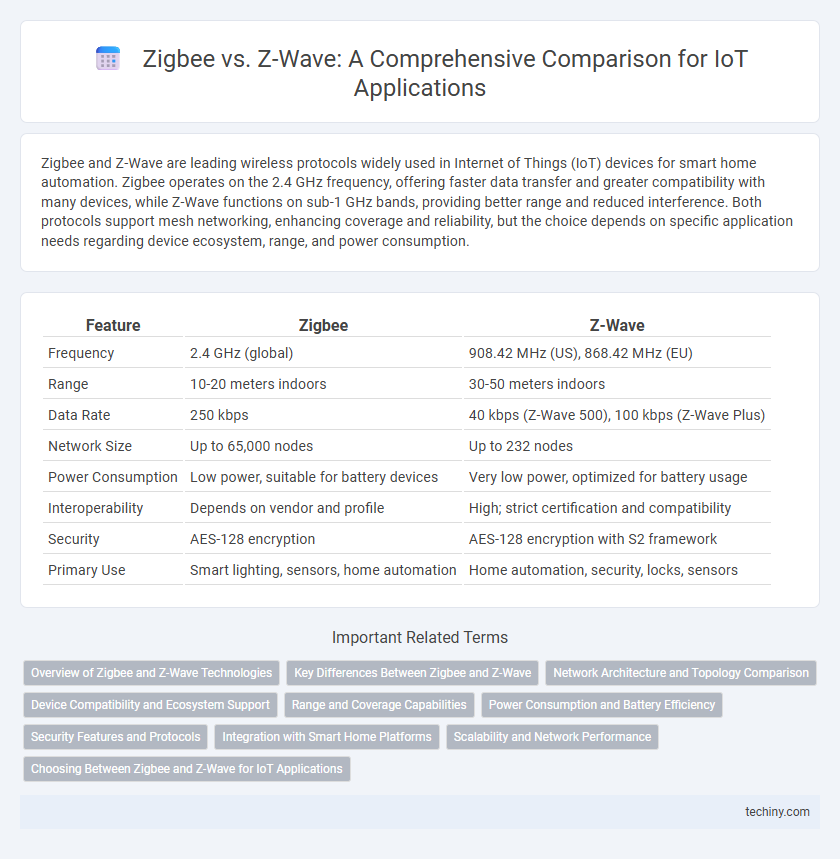Zigbee and Z-Wave are leading wireless protocols widely used in Internet of Things (IoT) devices for smart home automation. Zigbee operates on the 2.4 GHz frequency, offering faster data transfer and greater compatibility with many devices, while Z-Wave functions on sub-1 GHz bands, providing better range and reduced interference. Both protocols support mesh networking, enhancing coverage and reliability, but the choice depends on specific application needs regarding device ecosystem, range, and power consumption.
Table of Comparison
| Feature | Zigbee | Z-Wave |
|---|---|---|
| Frequency | 2.4 GHz (global) | 908.42 MHz (US), 868.42 MHz (EU) |
| Range | 10-20 meters indoors | 30-50 meters indoors |
| Data Rate | 250 kbps | 40 kbps (Z-Wave 500), 100 kbps (Z-Wave Plus) |
| Network Size | Up to 65,000 nodes | Up to 232 nodes |
| Power Consumption | Low power, suitable for battery devices | Very low power, optimized for battery usage |
| Interoperability | Depends on vendor and profile | High; strict certification and compatibility |
| Security | AES-128 encryption | AES-128 encryption with S2 framework |
| Primary Use | Smart lighting, sensors, home automation | Home automation, security, locks, sensors |
Overview of Zigbee and Z-Wave Technologies
Zigbee and Z-Wave are prominent wireless communication protocols in the Internet of Things (IoT) domain, each designed for low-power, short-range connectivity. Zigbee operates on the IEEE 802.15.4 standard and supports mesh networking, making it scalable for smart home and industrial automation with data rates up to 250 kbps. Z-Wave utilizes a sub-1 GHz frequency band, offering lower interference and better range around 100 meters per device, optimized for home automation devices requiring reliable, low-latency communication.
Key Differences Between Zigbee and Z-Wave
Zigbee operates on the 2.4 GHz frequency globally, while Z-Wave uses sub-1 GHz bands, resulting in less interference and longer range for Z-Wave. Zigbee supports larger mesh networks with up to 65,000 nodes compared to Z-Wave's 232 nodes, making it more scalable for extensive IoT setups. Z-Wave devices often provide better interoperability due to standardized protocols, whereas Zigbee offers higher data rates around 250 kbps versus Z-Wave's 100 kbps.
Network Architecture and Topology Comparison
Zigbee employs a mesh network topology that supports up to 65,000 nodes, enabling extensive scalability and robust self-healing capabilities, making it ideal for large IoT deployments. Z-Wave utilizes a mesh network with a maximum of 232 nodes, designed for simplicity and reliability in smart home environments, emphasizing low latency and power efficiency. While Zigbee's network architecture favors complex, high-density networks, Z-Wave provides streamlined connectivity optimized for interoperability and ease of use in residential settings.
Device Compatibility and Ecosystem Support
Zigbee offers broader device compatibility with thousands of products from leading brands, supporting interoperability across various smart home and industrial applications. Z-Wave operates on a more controlled ecosystem with a smaller device range but ensures strong interoperability through mandatory certification standards. Both protocols provide robust support, yet Zigbee's open standard and wider adoption enable greater ecosystem flexibility compared to Z-Wave's proprietary approach.
Range and Coverage Capabilities
Zigbee operates on the 2.4 GHz frequency band, providing a typical range of about 10 to 20 meters indoors, which extends through mesh networking to cover larger areas. Z-Wave uses a lower frequency around 900 MHz, offering better range in residential environments with about 30 to 50 meters indoors and enhanced penetration through walls and obstacles. The lower frequency of Z-Wave generally results in more reliable coverage over greater distances compared to Zigbee's higher frequency, making it ideal for larger homes or buildings.
Power Consumption and Battery Efficiency
Zigbee operates on low power consumption by utilizing a mesh network protocol that allows devices to transmit data with minimal energy, extending battery life significantly. Z-Wave, while also designed for low power usage, typically consumes slightly more energy due to its proprietary standards and lower data rates. Zigbee's efficiency in battery-operated devices makes it preferable for applications requiring longer battery life, whereas Z-Wave balances power consumption with enhanced range and interoperability.
Security Features and Protocols
Zigbee uses AES-128 encryption and supports network-level security with centralized trust centers, ensuring robust authentication and key management within mesh networks. Z-Wave also employs AES-128 encryption but features a proprietary protocol designed for low latency and secure device pairing through Security S2 framework, providing enhanced protection against replay attacks and man-in-the-middle threats. Both protocols prioritize secure communication, but Zigbee's open standard may offer broader interoperability, while Z-Wave's closed ecosystem emphasizes controlled, secure device interactions.
Integration with Smart Home Platforms
Zigbee integrates seamlessly with major smart home platforms like Amazon Alexa, Google Assistant, and Apple HomeKit, enabling robust device interoperability and control. Z-Wave offers strong compatibility with platforms such as SmartThings and Hubitat, providing reliable mesh networking for diverse smart home ecosystems. Both protocols support extensive device ecosystems, but Zigbee's widespread adoption often results in broader platform support and easier integration.
Scalability and Network Performance
Zigbee supports large-scale mesh networks with up to 65,000 nodes, making it highly scalable for extensive IoT deployments, while Z-Wave limits networks to 232 devices, which suits smaller installations. Zigbee operates in the 2.4 GHz band, offering higher data rates up to 250 kbps but potentially more interference, whereas Z-Wave uses sub-GHz frequencies (e.g., 908 MHz in the US), enabling better range and reduced interference, resulting in stable network performance. Both protocols utilize mesh networking to extend coverage and improve reliability, but Zigbee's higher node capacity and data throughput make it preferable for complex, high-density environments.
Choosing Between Zigbee and Z-Wave for IoT Applications
Zigbee offers higher data rates up to 250 kbps and supports larger mesh networks with thousands of devices, making it suitable for dense IoT deployments. Z-Wave excels in interoperability and operates in the sub-1 GHz band, reducing interference with Wi-Fi and enhancing range up to 100 meters indoors. Selecting between Zigbee and Z-Wave depends on factors like device ecosystem compatibility, required communication range, and network size for the specific IoT application.
Zigbee vs Z-Wave Infographic

 techiny.com
techiny.com